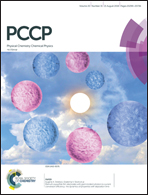Multiporous sp2-hybridized boron nitride (d-BN): stability, mechanical properties, lattice thermal conductivity and promising application in energy storage†
Abstract
All-solid-state lithium–sulfur (Li–S) batteries offer the possibility of high theoretical energy densities and long cycle lifetime. Finding new multiporous insulating materials or wide bandgap semiconductors suitable for the transportation of Li-ions is a key problem for the application of solid state lithium–sulfur (Li–S) batteries. In this study, an sp2-hybridized multiporous boron nitride (d-BN) is found to be able to be used as a solid electrolyte or filter in Li–S batteries due to the lower energy barriers of Li-ion diffusion along its [110] direction. By means of density functional theory (DFT) calculations, it is also found that the d-BN is more stable than most reported BN polymorphs. In addition, the elastic properties, ideal tensile strength, electronic structure, lattice thermal conductivity and phonon lifetime of d-BN are also investigated.



 Please wait while we load your content...
Please wait while we load your content...